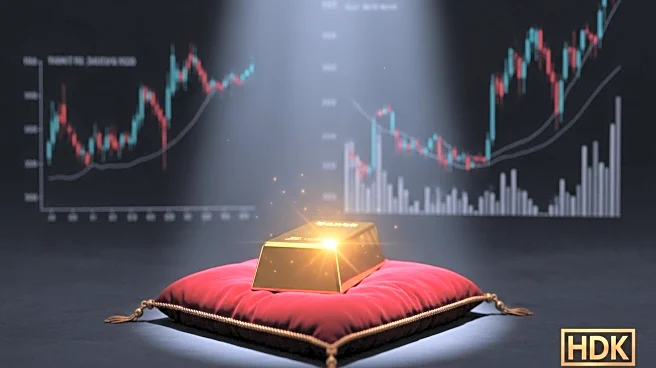What's Happening?
Gold prices have surged to a new record high, reaching $4,254.61 per ounce, driven by escalating U.S.-China trade tensions and expectations of interest rate cuts by the Federal Reserve. The metal has seen
a significant increase of over 60% year-to-date, fueled by geopolitical uncertainties, central bank purchases, and strong ETF inflows. The ongoing U.S. government shutdown has further contributed to economic uncertainty, enhancing gold's appeal as a safe-haven asset. Analysts suggest that gold's future trajectory will depend on the rate-cut outlook and developments in U.S.-China relations, with potential for further increases if tensions persist.
Why It's Important?
The rise in gold prices reflects broader economic and geopolitical dynamics, impacting investors and financial markets. As a traditional safe-haven asset, gold's increased value signals heightened investor concern over global stability and economic policy. The potential Federal Reserve rate cuts could lower borrowing costs, influencing investment strategies and economic growth. Additionally, the U.S.-China trade tensions and government shutdown may affect global supply chains and economic output, with gold serving as a hedge against these uncertainties. Stakeholders in the financial sector, including investors and policymakers, are closely monitoring these developments.
What's Next?
The future of gold prices will likely be influenced by upcoming Federal Reserve decisions on interest rates, with traders anticipating cuts in October and December. The U.S.-China trade relationship remains a critical factor, as unresolved tensions could further drive gold prices upward. Analysts predict that if no resolution is reached, gold could potentially surpass the $5,000 per ounce mark. The ongoing government shutdown may also continue to impact economic data and market sentiment, prompting further shifts in investment strategies.
Beyond the Headlines
The surge in gold prices highlights deeper economic and geopolitical challenges, including the impact of de-dollarization and central bank strategies on global markets. The shift towards gold as a safe-haven asset underscores concerns about currency stability and economic policy effectiveness. Long-term implications may include changes in investment patterns and increased focus on alternative assets amid persistent geopolitical tensions.











